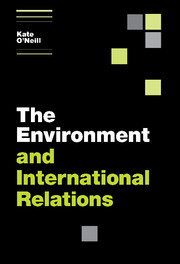Book contents
- Frontmatter
- Contents
- Preface
- Acknowledgements
- List of commonly used abbreviations
- 1 Introduction: The environment and international relations
- 2 International environmental problems
- 3 Actors in international environmental politics
- 4 State-led global environmental governance: International cooperation and regime formation
- 5 The impacts and effectiveness of environmental treaty regimes
- 6 Global economic governance and the environment
- 7 Non-state global environmental governance
- 8 Conclusions: The environment and international relations in the twenty-first century
- References
- Index
- References
1 - Introduction: The environment and international relations
Published online by Cambridge University Press: 05 June 2012
- Frontmatter
- Contents
- Preface
- Acknowledgements
- List of commonly used abbreviations
- 1 Introduction: The environment and international relations
- 2 International environmental problems
- 3 Actors in international environmental politics
- 4 State-led global environmental governance: International cooperation and regime formation
- 5 The impacts and effectiveness of environmental treaty regimes
- 6 Global economic governance and the environment
- 7 Non-state global environmental governance
- 8 Conclusions: The environment and international relations in the twenty-first century
- References
- Index
- References
Summary
The question of when, if, and how well national governments cooperate to address shared environmental problems, from climate change to biodiversity loss to international trade in hazardous wastes, to name but a few, is central to the relationship between international relations theory and the environment. For many years now, the tools of political science, and specifically of the discipline of international relations, have been applied to the complex set of questions around global environmental change and global environmental governance. At the same time, insights from this body of work have informed and shaped our broader understanding of the workings of international politics, and the emphases and directions of specific theoretical approaches within the academic discipline.
However, if there is one thing that the global politics of the environment have taught us, it is that traditional political science and international relations approaches have limits when applied to problems of such political, scientific, and social complexity as those associated with global environmental change. A whole spectrum of perspectives, approaches, and tools from many different disciplines help explain the nature of the global environmental crisis and offer possible solutions. Some of these perspectives have their origin in the world of practice and policymaking, others in other social science disciplines. Many of these perspectives lie well outside the traditional disciplinary parameters of international relations theory, but are becoming more central to debates within the field of international – or global – environmental politics.
- Type
- Chapter
- Information
- The Environment and International Relations , pp. 1 - 23Publisher: Cambridge University PressPrint publication year: 2009
References
- 1
- Cited by



